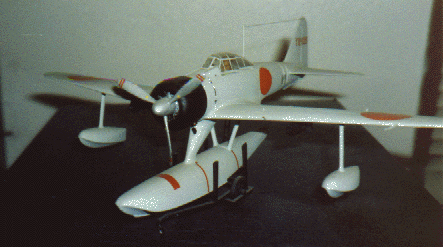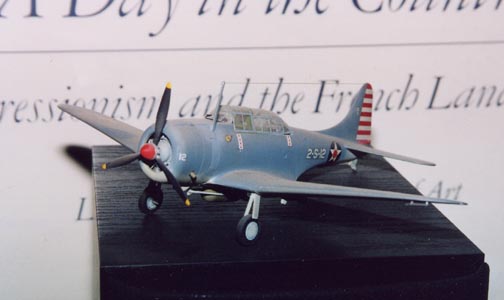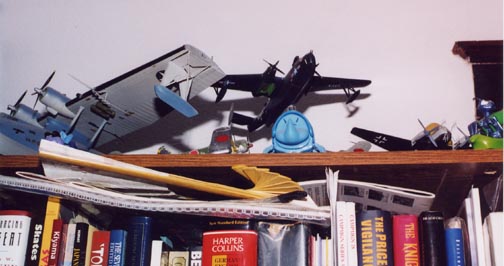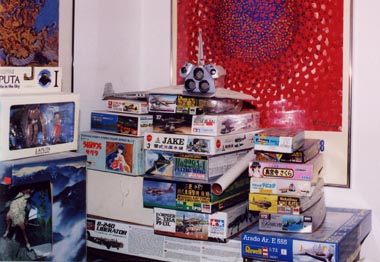Favorite Model Kits


I'm not the world's greatest modeler, but I'm improving. I guess you
just have to keep on practicing. I started doing this when I had
pneumonia and couldn't do much else. I also have an interest in WWII
vintage aviation. A lot of planes from those days are gone, or hard to
see, so the only way to get an idea of what they looked like is to
build a model. Like everyone else, I have an incredible backlog of
models that need to be built.
Also some hints for other novice modelers. Superglue, the
special stuff they sell in model shops, such as Zap-a-Gap, is the key,
plus an accelerator. You'll need all three of the different types of
Superglue: super thin, super thick, and normal. However, don't use it
on clear parts! (I wish I had known the first few models.) Instead, use
white glue or the special clear drying glue (looks suspiciously like
white glue, but more expensive) you can buy in model shops. Use the
thin Superglue for joining together fuselage or hull halves. Use the
thick stuff and the accelerator instead of putty for filling gaps. It
can be filed and sanded. You can also use white glue for very minor
filling.
For aerials and rigging, don't use regular sewing thread. Use either the special
thin thread for tying fishing flies or sprull. What is sprull? Take a piece
of plastic parts tree, heat in the center carefully, and PULL! Depending on
the temperature and how you pull, you can get thin threadlike strands of whatever
thickness you desire.
Sell your soul, but get an air brush and a compressor. This will lead to heart
ache and ecstasy. Also get a real filter mask to save your health. The Paasche
H brush is a good place to start. I like my Badger compressor. Forget about
the propellant in a can. Now suffer. The key here is to keep everything clean
and to ensure your paint is properly thinned and strained if necessary. Try
to use the water based acrylic paints instead of the enamels if possible. However,
they require more cleaning. Use silver paint as a primer, but careful which
one you choose. I just made a big mistake with chrome silver. Silver plate works
well if you can afford it. Make sure to buff it before applying colors over
it. Definitely use aluminum plate for bare metal finishes. Don't prime under
it. The surfaces have to be perfect before you apply it.
For painting canopies, mask, use a fresh blade in an X-acto
knife and cut away the material over the framework. Airbrush with the
internal color, and then with the final color. Make sure the masking
material is down really well. Remove residual masking adhesive with
scotch tape if necessary. Scotch tape also works for masking flat
surfaces.
The key to decals is to have a smooth surface. Make sure that you airbrush
on clear lacquer before you try the decals. You can get the acrylic stuff and
it works. Also try Future floor wax. I should try it on my Linoleum someday.
Depending on the decals, look into setting solutions, such as the Microsol line
or vinegar. When the instructions warn not to use them, believe them! Tamiya
decals don't appear to respond well to the setting solutions.
Here's a list of some of my model kits.
References:
|
 |
Some other models I've built that haven't gone to my cubicle (the graveyard) or the trash.
- Revell-Monogram 1/48 PBY-4. I liked this so much I have a PBY-5 stored that
I want to build as a Black Cat someday.
- Revell retro Marlin re-release. Another kit I once did as a kid. Cute kit,
even if the gun barrels are way too thick.
- Revell (Korea) Type XXI U-boat. It took me two tries to build this one.
I destroyed the first kit, but salvaged the decals from it. The kit itself
is beautiful. The problems were all mine.
- Hasegawa 1/72 Hayate
- Hasegawa 1/72 Hayabusa nice simple model
- Hasegawa 1/72 SBD-5 (I dropped it and lost one of the radar aerials. I'll
have to replace it some day. I ended up giving it away.
- 1/48 P-36 good model from Hobbycraft.
- 1/72 kitbashed Hellcat.
- Hasegawa 1/48 SBD-3. I want to do this one again Wings didn't mate that
well
- Revell 1/72 snaptite B-26 that I tried to improve as an early 1942 version.
- Revell-Monogram 1/48 Helldiver. Nice model. Those bulges at the bottom of
the canopy are correct.
- Ertl 1/72 Flying Wing, the experimental version with the double counter-rotating
props. Fit is very poor on this model- requires a lot of work.
- Revell (Germany) Condor. A truly horrible kit with parts that fit like they
came from different kits. I like the way it came out, but the decals were
in bad shape and I damaged the unit insignia. Many of the others I replaced
from my stock.
- Hobbycraft 1/48 Arado 234 jet bomber, the four engine version Easy to build
model
- Spruce Goose, out of loyalty to my former employer. This one had warped
parts, but isn't too bad.
- P-70 nightfighter in 1/48 from ERTL. Pretty decent kit.
- Bearcat in 1/48 from Hobbycraft. A pretty good model.
- F-14 in 1/144. Basically just a block of plastic.
- Revell (Korean) Type XXI U-boat.
- Waterline 1/700 model of the cruiser Maya
Some links to my own galleries of photos of trips to air museums for reference
- September 24, 2024 Hill Aerospace Museum Photos
- September 23, 2024 Historic Wendover Airfield Museum Photos
- September 20, 2024 Castle Air Museum Photos
- May 8, 2024 Mid-America Air Museum Photos
- May 4, 2024 Carillon History Park Photos
- May 3, 2024 Air Force Museum, Part 2 Photos
- May 3, 2024 Air Force Museum, Part 1 Photos
- April 29, 2024 Udvar-Hazy Center Photos
- April 15, 2024 The National WWII Museum Photos
- March 28, 2024 Space History Museum Photos
- March 26, 2024 Pima Air & Space Museum Photos
- December 19, 2023 Lyon Air Museum Photos
- November 11, 2023 Commemorative Air Force Museum Photos
- October 15, 2023 Palm Springs Air Museum Photos
- August 27, 2023 Flightpath Museum Photos
- September 24, 2022 Museum of Flight outdoors Photos
- September 23, 2022 Evergreen Aviation Spruce Goose Photos
- September 23, 2022 Evergreen Aviation Museum Space Photos
- September 23, 2022 Evergreen Aviation Museum Photos
- June 2, 2022 Estrella Aviation Museum Photos
- September 19, 2019 Flying Heritage and Armor Museum Photos
- May 7, 2019 China Lake Museum Photos
- May 6, 2019 Saxon Aerospace Museum Photos
- December 1, 2018 Nike Missile museum openhouse Photos
- July 21, 2018 Zero and P-40 at Western Museum of Flight Photos
- August 19, 2017 Wilbur Wright Birthplace and Museum Photos
- August 18, 2017 NATIONAL MUSEUM OF THE US AIR FORCE Photos
- August 11, 2017 Weisbrod Aviation Museum Photos
- January 13, 2017 National Atomic Testing Museum Photos
- September 4, 2016 Aerospace Museum of California Photos
- September 2, 2016 Castle Air Museum Photos
- April 26, 2016 Planes of Fame Museum in Valle Photos
- Sept 24, 2015, Roswell Museum & Art Center Photos
- Sept 17, 2015, Udvar-Hazy Center Photos
- Sept 6, 2015, Cole Transportation Museum Photos
- Aug 26, 2015, New England Air Museum Photos
- July 30, 2015, Dayton Aviation Heritage Park Photos
- July 28, 2015, Greenfield Village Photos
- July 27, 2015, Greenfield Village Photos
- July 16, 2015, National Museum of WW2 Aviation Photos
- April 3, 2015, White Sands Missile Range Museum Photos
- June 19, 2014 War Eagles Aviation Museum Photos
- January 21, 2011 March Field Air Museum, Photos
- September 27, 2010 Kennedy Space Center, Photos
- June 02, 2010 Aberdeen Proving Grounds Museum, Photos
- June 01, 2010 Smithsonian Udvar-Hazy Air & Space Museum, Photos
- June 01, 2010 Marine Corps Museum, Triangle, VA, Photos
- May 18, 2010 Pima Air & Space Museum, Photo
- May 18, 2010 AMARG Boneyard, Photos
- 2009 Pacific Coast Air Museum Photos
- Aug 28, 2008 Evergreen Aviation Museum Photos
- 2007 San Diego Air & Space Museum
- 2006 Hiller San Carlos, CA
- 2004 Museum of the NASM in Chantilly where I took some photos
- 2002 Dryden Test Center at Edwards AFB
- 2002 Pima Air Museum (guest gallery)
- 2002 Duxford, England
- 2002 Hendon, England
- 2002 Cosford, England
- 2002 NASM, Washington DC
- 2002 College Park, Maryland
- 2004 Udvar-Hazy
- The Garber restoration facility in Maryland
- A second trip to the Garber in 2001
- 2001 The Planes of Fame museum in Chino,
California
- 2001 Castle Air Museum
- 1999 The National Naval Aviation Museum
in Pensacola

Like everyone else, I have enough unbuilt kits to last me through several
lifetimes. Someday I'll inventory them. I can hardly use my closets for clothes.
Well, I did run out of closet space and now the model are just everywhere:

[2025 note: Actually, I did end up giving most of them away]




Last Update: 6 January 2024
Web Author: Doug Ikemi




